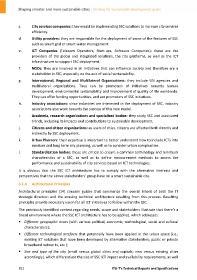Page 362 - Shaping smarter and more sustainable cities - Striving for sustainable development goals
P. 362
c. City services companies: they would be implementing SSC solutions to increase city services
efficiency.
d. Utility providers: they are responsible for the deployment of some of the features of SSC
such as smart grid or smart water management.
e. ICT Companies (Telecom Operators, Start‐ups, Software Companies): these are the
providers of the global and integrated solutions, the city platforms, as well as the ICT
infrastructure to support SSC deployment.
f. NGOs: they are involved in all initiatives that can influence society and therefore are a
stakeholder in SSC, especially on the axis of social sustainability.
g. International, Regional and Multilateral Organizations: they include UN agencies and
multilateral organizations. They can be promoters of initiatives towards human
development, environmental sustainability and improvement of quality of life worldwide.
They can offer funding opportunities, and are promoters of SSC initiatives.
h. Industry associations: since industries are interested in the deployment of SSC, industry
associations also work towards the success of this new model.
i. Academia, research organizations and specialized bodies: they study SSC and associated
trends, including its impacts and contributions to sustainable development.
j. Citizens and citizen organizations: as users of cities, citizens are affected both directly and
indirectly by SSC deployment.
k. Urban Planners: their expertise is important to better understand how to include ICTs into
medium and long term city planning, as well as to consider urban complexities.
l. Standardization bodies: these are critical to ensure a common terminology and minimum
characteristics of a SSC, as well as to define measurement methods to assess the
performance and sustainability of city services based on ICT technologies.
It is obvious that the SSC ICT architecture has to comply with the alternative interests and
perspectives that the above stakeholders' group have on a smart sustainable city.
6.1.4 Architectural Principles
Architectural principles [14] concern guides that summarize the overall intent of both the IT
strategic direction and the ensuing technical architecture resulting from this process. Resulting
principles provide necessary vision for all ICT initiatives to follow within the SSC.
The previously identified context regarding needs, scope and stakeholders illustrate that there's a
broad environment where the SSC ICT architecture has to be applied, which addresses:
Different geographic areas (with various political, economic, technological, social and cultural
characteristics);
Different technological artefacts that potentially have been applied in the urban space (i.e.,
existing ICT solutions that have been developed by alternative stakeholders; public or private
broadband networks, etc.);
Size and type of the city (small versus global cities and capitals; new versus existing cities
accordingly), which differentiate the size of SSC ICT impact and availability requirements, as well
352 ITU‐T's Technical Reports and Specifications

